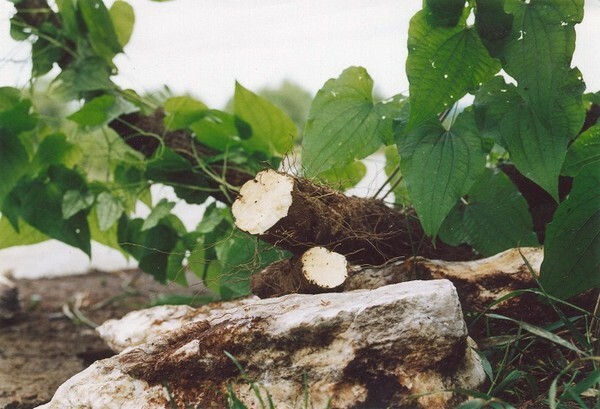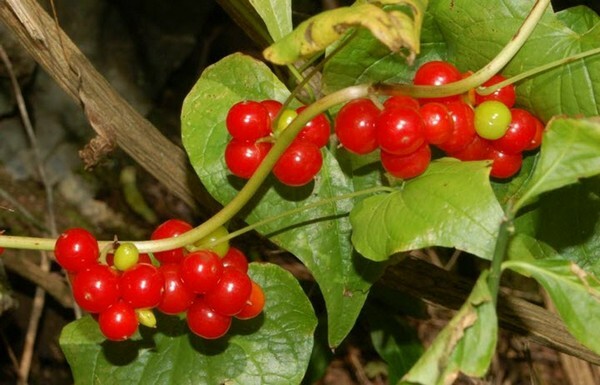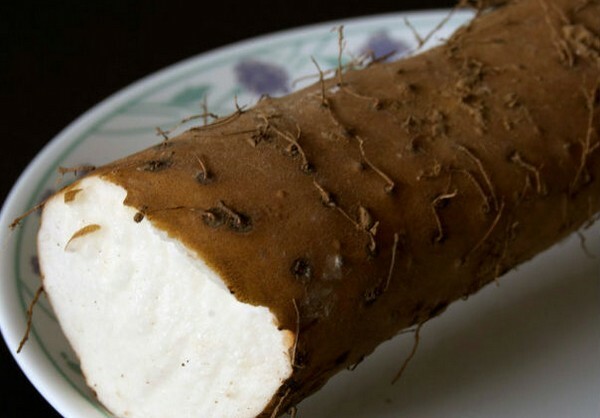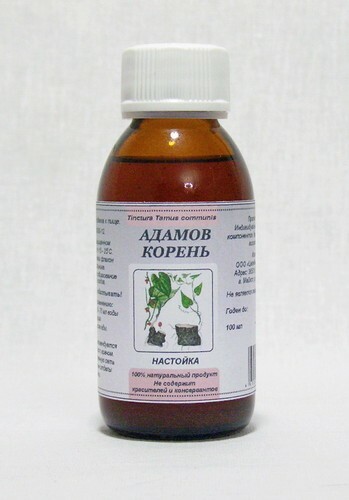- Botanical Description
- Therapeutic Properties
- Methods of Application
Adam's root is a perennial herbaceous plant belonging to the family of Dioscoreae. It is used in folk and traditional medicine, it is produced in the form of crushed dry raw materials and alcohol tincture. Often it can be seen in the composition of ready-made herbal preparations or ointments, balms and creams intended for the treatment of diseases of the musculoskeletal system. In the wild in nature, the plant is found most often in mountain forests, especially beech or chestnut, Central Asia, the Caucasus, and Europe. Some cultivate it for decorative purposes for landscaping areas, due to the fact that it is characterized by high frost resistance. The plant is also known as Tamus vulgaris, inaccessible, Bryonia white, sebaceous, snake or fire root, white whit, etc.

Botanical description
In appearance, the thamus is a creeping liana of several stems up to 4-5 m long which may haveThe spines or tendrils that help to cling to the support.
TAMUS is a dioecious plant. Flowers are small, have a yellowish-green color, are collected in inflorescences( axillary brushes), appear from April to June. Fruits are round berries of red color( about 10 mm in diameter).Appear from July to September. Each berry contains 3 to 6 round seeds with a diameter of about 3 mm in red or dark brown color. The exact time for the beginning of flowering and fruiting is determined for the Adam's root by the terrain where it grows.
The root is massive, thick, rod-shaped, can be two- or three-parted. Outside it is painted in a dark brown or dark brown color, inside is white. The consistency of juicy, oily, to the touch fat. The length can reach 1 m, and the weight - 10 - 15 kg.
The leaves are large with jagged edges an average of 10 cm in length, rough to the touch, have carved edges, long petioles, arranged alternately on the stalk. The leaf plate is egg-shaped with a heart-shaped, tapering upward base.

The healing properties of
The plant contains in its composition a lot of biologically active substances, which allows using it for medicinal purposes. Among them are tannins, saponins, pectins, glycosides, essential and fatty oils, resins, organic acids, alkaloids, mucus, etc. It is also rich in various microelements necessary for soft tissues and bones.
Based on the Adam's root, they are used to treat a wide variety of diseases, because they:
- reduce inflammation;
- activates the processes of local circulation;
- have an antiseptic effect;
- promote the regeneration of damaged tissues;
- reduce pain syndrome, reduce swelling;
- exhibits antioxidant properties;
- have a diuretic effect;
- contribute to the purification of blood and the stopping of bleeding;
- strengthen the vessels.
Means from a root of Adam help well in diseases of bone tissue, joints, muscles, ligaments and inflammation of nerves. They contribute to the reduction of pain in rheumatism, sciatica, radiculitis, heel spur, osteochondrosis, gout, arthritis and arthrosis, increased mobility of the joints. Due to the high content of mineral substances they promote good mineralization of the bone, help to recover faster after injuries, fractures, bruises, sprains and dislocations, accelerates the disappearance of bruises, bruises and bruises on the skin.

are located along the whole surface of the thamus. The plant increases the tone of the vessels, strengthens and cleanses their walls, therefore the root has been applied in folk medicine as an effective remedy for such diseases of veins as varicose veins, hemorrhoids and thrombophlebitis.
Also, tamus vulgaris is used for some skin problems, in particular for combating warts, pigment spots, in the complex treatment of eczema, furunculosis, trophic ulcers, etc.
Sometimes, thanks to antiseptic and anti-inflammatory action, the thamus is used for cystitis, nephritis, bronchitis,pneumonia, adnexitis, peptic ulcer.
How to use
For medicinal purposes, the root of the plant is used primarily, rarely the leaves and berries. From it are prepared tinctures, decoctions, infusions, ointments, balms, which are used mainly externally in the form of lotions, rubbing, poultices, compresses and for massages.
Important: Internal use of funds from the root of the plant requires special care because of its toxicity.
For the preparation of tamus-based products, you can use ready-made dry raw materials from the pharmacy or make a blank yourself in the spring( before the flowering) or autumn( after the ripening of the fruit).To do this, the root must be excavated, cleaned of the ground and roots of other plants, often confused with it, washed with running water. Then cut into thin plates and dry in a cool, sheltered from the sun place. Drying can also be done outdoors in the shade. Healing properties of dry raw materials are preserved for two years when stored in cardboard or paper packaging in a ventilated room.
Important: When self-preparing the Adam's root, protective clothing is needed, since its juice has an irritant effect on the skin!
Vodka tincture for external use
It is used for rheumatism, radiculitis, osteochondrosis and joint pain. To get 200 g of crushed raw material from the Adam's root, put them in a dark container and pour 500 ml of vodka, leave for 12 days, shaking periodically, and then filter. The resulting remedy rubs the sore spots before going to bed, then wraps them with a blanket or dresses over warm woolen clothes.
Poultice
Used for rheumatism and sciatica. For its preparation 2 tbsp.l.crushed roots pour a glass of boiling water and cover, cover for 5 minutes, drain the water, wrap the roots in gauze and apply to the affected places twice or thrice a day.Alcohol tincture for internal use
It is used for diseases of joints, adnexitis, ovarian cysts. Shredded dried root( 1 tbsp.) Is poured into 500 ml of alcohol with an ethanol content of 60-70%, insisted in a dark place for two weeks, periodically shaking. Then filter and ingest 15 ml of tincture per 60 ml of water three times a day after ingestion for three months.

Mixture for diseases of the digestive and respiratory organs
Mix 30 g of dry ground tamus root, 350 g of melted butter and 300 g of liquid honey. Insist during the day. The received product is ingested by 1 tsp.twice a day 20 minutes after eating until the symptoms of the disease are reduced.
Oil tincture
It is used for diseases of joints, varicose veins, bruises, bruises. To make it, 50 g of the ground adam root is poured into 500 ml of sunflower unrefined oil and insisted in the refrigerator for 12 to 14 days. Later used for massage and rubbing problematic areas without straining.
Poultice from fresh root
Applied with bruises for analgesia. Fresh root is finely chopped or rubbed on a large grater, doused with boiling water and applied to a sore spot, wrapped in gauze.
Ointment
It is used for pain in the joints. In a proportion of 10 to 1, mix petroleum jelly and crushed in a gruel on a small grater or a blender of fresh adam root. Ointment is stored in the refrigerator in hermetically sealed containers. Used for massage and rubbing joints patients thrice a day before the pain syndrome decreases.
Powder
With a thoroughly ground powder of the Adam's root, fresh wounds, abscesses, trophic ulcers and inflammations on the skin are sprinkled on top with a sterile gauze dressing. With dermatitis, warts, eczema, this powder is mixed with boric ointment and treated affected areas.
Warning: All parts of the root of Adam are poisonous, therefore, cooking recipes and recommended methods of treatment when using it should be strictly observed! Their use is permissible only after consultation with a doctor.
Preparation of the tincture of the Adam's root:
